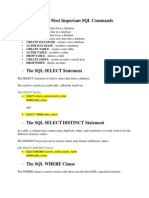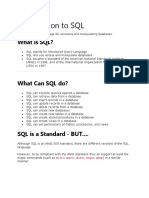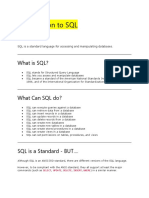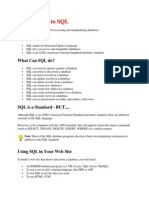1.
What is sql:
SQL stands for Structured Query Language
SQL lets you access and manipulate databases
SQL is an ANSI (American National Standards Institute) standard
2.
SQL SELECT Syntax:
SELECT column_name,column_name
FROM table_name;
and
SELECT * FROM table_name;
3.
The SQL SELECT DISTINCT Statement:
In a table, a column may contain many duplicate values; and sometimes you only want to list the different
(distinct) values.The DISTINCT keyword can be used to return only distinct (different) values.
SQL SELECT DISTINCT Syntax:
SELECT DISTINCT column_name,column_name
FROM table_name;
e.g: SELECT DISTINCT City FROM Customers;->Gives all distinct city names only.
4.
The SQL WHERE Clause:
The WHERE clause is used to extract only those records that fulfill a specified criterion.
SQL WHERE Syntax:
SELECT column_name,column_name
FROM table_name
WHERE column_name operator value;
e.g: SELECT * FROM Customers ->Gives complete table having mexico city only.
WHERE Country='Mexico';
Operators in The WHERE Clause:
The following operators can be used in the WHERE clause:
Operator
Description
Equal
<>
Not equal. Note: In some versions of SQL this operator may be written as !=
�>
Greater than
<
Less than
>=
Greater than or equal
<=
Less than or equal
BETWEEN
Between an inclusive range
LIKE
Search for a pattern
IN
To specify multiple possible values for a column
5.
The SQL AND & OR Operators:
The following SQL statement selects all customers from the country "Germany" AND the city
"Berlin", in the "Customers" table:
e.g:SELECT * FROM Customers
WHERE Country='Germany'
AND City='Berlin';
The following SQL statement selects all customers from the city "Berlin" OR "Mnchen", in the
"Customers" table:
e.g:SELECT * FROM Customers
WHERE City='Berlin'
OR City='Mnchen';
The following SQL statement selects all customers from the country "Germany" AND the city must be
equal to "Berlin" OR "Mnchen", in the "Customers" table:
e.g:SELECT * FROM Customers
WHERE Country='Germany'
AND (City='Berlin' OR City='Mnchen');
6.
The SQL ORDER BY Keyword:
The ORDER BY keyword is used to sort the result-set by one or more columns.The ORDER BY keyword sorts the
records in ascending order by default. To sort the records in a descending order, you can use the DESC keyword.
�SQL ORDER BY Syntax:
SELECT column_name,column_name
FROM table_name
ORDER BY column_name,column_name ASC|DESC;
The following SQL statement selects all customers from the "Customers" table,
sorted by the "Country" column:
e.g:SELECT * FROM Customers ORDER BY Country;
The following SQL statement selects all customers from the "Customers" table, sorted DESCENDING by
the "Country" column:
e.g:SELECT * FROM Customers ORDER BY Country DESC;
The following SQL statement selects all customers from the "Customers" table, sorted by the "Country"
and the "CustomerName" column:
e.g:SELECT * FROM Customers ORDER BY Country,CustomerName;
7.
The SQL INSERT INTO Statement:
The INSERT INTO statement is used to insert new records in a table.
SQL INSERT INTO Syntax:
It is possible to write the INSERT INTO statement in two forms.The first form does not specify the column names
where the data will be inserted, only their values:
INSERT INTO table_name
VALUES (value1,value2,value3,...);
The second form specifies both the column names and the values to be inserted:
INSERT INTO table_name (column1,column2,column3,...)
VALUES (value1,value2,value3,...);
Assume we wish to insert a new row in the "Customers" table.We can use the following SQL statement:
e.g:INSERT INTO Customers (CustomerName, ContactName, Address, City, PostalCode, Country)
VALUES ('Cardinal','Tom B. Erichsen','Skagen 21','Stavanger','4006','Norway');
It is also possible to only insert data in specific columns.The following SQL statement will insert a new row, but
only insert data in the "CustomerName", "City", and "Country" columns (and the CustomerID field will of course
also be updated automatically):
�e.g:INSERT INTO Customers (CustomerName, City, Country)
VALUES ('Cardinal', 'Stavanger', 'Norway');
8.
The SQL UPDATE Statement:
The UPDATE statement is used to update existing records in a table.
SQL UPDATE Syntax:
UPDATE table_name
SET column1=value1,column2=value2,...
WHERE some_column=some_value;
Assume we wish to update the customer "Alfreds Futterkiste" with a new contact person and city.We use
the following SQL statement:
e.g:UPDATE Customers
SET ContactName='Alfred Schmidt', City='Hamburg'
WHERE CustomerName='Alfreds Futterkiste';
Be careful when updating records. If we had omitted the WHERE clause, in the example above, like this:
e.g:UPDATE Customers
SET ContactName='Alfred Schmidt', City='Hamburg';
9.
The SQL DELETE Statement:
The DELETE statement is used to delete rows in a table.
SQL DELETE Syntax:
DELETE FROM table_name
WHERE some_column=some_value;
Assume we wish to delete the customer "Alfreds Futterkiste" from the "Customers" table.We use the
following SQL statement:
e.g:DELETE FROM Customers
WHERE CustomerName='Alfreds Futterkiste' AND ContactName='Maria Anders';
It is possible to delete all rows in a table without deleting the table. This means that the table structure,
attributes, and indexes will be intact:
DELETE FROM table_name;
or
DELETE * FROM table_name;




















































































